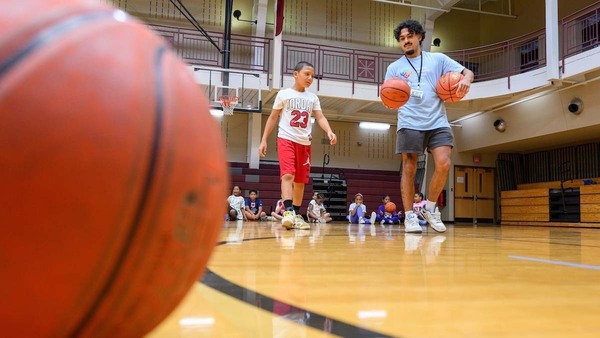Sports program promotes health and wellness, offers life lessons to Robinson Center youth

On a recent Wednesday, a group of kids ranging in age from about 6 to 11 climbed aboard a waiting van and traveled the three miles south from the Robinson Community Learning Center (RCLC) to Studebaker Golf Course in South Bend, home to the John and Kathy Postle Golf Learning Center. Spilling out of the van in the tiny parking lot, the kids walked excitedly through the arched entry gate, past the first tee box and into the clubhouse, where Jenny Zimmerman, director of First Tee Indiana in Michiana, was waiting for them.
Noting the presence of lightning in the area, Zimmerman, a former collegiate golfer, offered a quick lesson in weather safety: “One thing about golf, when there’s lightning, we gotta move inside,” the former full-time attorney said.
Developed on land donated to the city by the Studebaker family, Studebaker Golf Course is South Bend’s oldest golf course, dating to 1919. Its nine holes total just 1,900 yards, and with few hazards, it plays like a par 3 course — short and easy. For countless area golfers, it’s where they got their start.
The John and Kathy Postle Golf Learning Center was added to the course as a 2,800-square-foot addition to the clubhouse in 2021, complete with a golf course simulator, a putting green, classroom space and a kitchen overlooking the practice green.
With bad weather threatening, the kids split into groups and practiced their putting, chipping and driving skills from the comfort of the learning center, absorbing important lessons in the process.
“We are about 75 percent life skills and values and about 25 percent golf,” Zimmerman said. “So, although we teach kids how to hold a golf club and how to make contact with the ball and all of those things, we’re also teaching them honesty and integrity, sportsmanship, growing through challenges and setting goals, appreciating diversity — all of those things that they need outside of the game of golf.”
Such values are not specific to golf, however, which is why the RCLC took a broad view this year when considering how best to incorporate sports into its annual Summer Scholars & Day Camp program.
In addition to golf, kids spent time each Wednesday learning about basketball at Holy Cross College, baseball at Foundry Field, tennis at Adams High School and ice skating at Compton Family Ice Area — part of an effort to introduce them to a wide-range of activities while imparting important lessons about things such as teamwork, sportsmanship and self-discipline.
In preparation for this, the kids were presented with a list of sports at the start of the summer and asked to rank them by choice. They were then assigned to one based on those rankings, taking into account the available number of spaces at each location. Whenever possible, the kids were assigned to their sport of first or second choice.
Spanning six weeks between the typical spring and fall semesters, the Summer Scholars & Day Camp program offers math and reading lessons in the mornings and cultural and recreational programming in the afternoons to kids in grades 1 through 8.

“Part of the magic of the Robinson Center summer is that fun and play every afternoon keeps kids coming back for the important academic ‘work’ they do at camp every morning,” said Clare Roach, associate director of the RCLC, an off-campus educational initiative of the University of Notre Dame that offers year-round programming and serves as a gathering place for area youth and adults.
Susan Devetski, director of the RCLC, added, “The ultimate goal isn't athletic excellence but rather proficiency to give kids a chance to feel confident enough to engage in a sport perhaps in high school or with friends for fun.”
Ditching screens
In the present, it also teaches kids ways to pass the time without screens, which, whether at home or school, increasingly occupy their days.
According to the American Academy of Child and Adolescent Psychiatry, children ages 8 to 18 in the U.S. spend an average of seven and a half hours a day in front of a screen. And while the relationship between such exposure and mental and physical health is complex, mounting evidence points to a correlation between excessive screen time and problems such as obesity, lack of sleep, low self-esteem and lower grades in school.
“In thinking about the program, we wanted the kids to participate in something that mitigates negative mental health outcomes, keeps them off screens and gives them an opportunity to become proficient at a sport they might not otherwise have an opportunity to experience,” Devetski said, adding, “We hope that kids might grab a racket, or their gym shoes or head out to a golf or skating activity long after this camp is over because they have the confidence and experience to do so, thus planting the seeds for life long health and well-being.”
Currently operated as a pilot, the program is a collaboration among the RCLC and several local partners, including Notre Dame Athletics, the Institute for Social Concerns, AmeriCorps, Holy Cross College, the South Bend Community School Corp., South Bend Venues Parks and Arts, the United States Tennis Association and First Tee, among others.
Phil Robles, an AmeriCorps member assigned to the RCLC, led the basketball portion of the program at Holy Cross, where he played collegiately before graduating in May. Robles grew up in South Bend. He played high school basketball at Riley High School on the city’s south side.
“It’s been great,” Robles said of the experience. “I love working within the community I grew up in … just being around the kids and coming in to serve every day and seeing their faces. I know Wednesdays are a big day because they get to go play their sport and they’re so excited on the bus talking about it and they continually talk about it throughout the week. So, it’s been amazing.”
Back at Studebaker, Riley Crump, 11, was taking a break from practicing her chip shots.
She said in choosing which sport to play this summer, her mom encouraged her and her twin sister to take up golf as one of the few they’d never tried before.

So far, she loves it.
“I think it’s my new sport now,” she said, noting that unlike basketball where “you get shoved a lot, it’s a sport where you don’t get hurt.”
Nearby, Adelaide Chase, 9, was practicing hitting foam balls into a chipping net, an instructor looking on.
Asked what she liked about golf, she said, shyly, “I like that I can relieve my anger.”
How so?
“By hitting (the ball) as hard as I can.”
She said her favorite part about golf — aside from not having to catch things like in basketball and baseball — was “watching yourself improve.”
Zimmerman, for her part, had nothing but praise for the kids and for RCLC leadership as well.
“It’s been fantastic,” she said. “The leaders at the RCLC are among the best in the community that we’ve worked with. They get involved with the kids; they’re respectful of the kids; the kids are respectful of them, and that then translates to us.”
She added, “I think it’s going to be a great partnership going forward, and I hope they (the RCLC) feel the same way.”
Latest ND NewsWire
- Institute for Educational Initiatives launches free math app to help teachers strengthen students’ understanding of numbers and operationsThe free Number Sense Assessment app is available to educators nationwide and offers quick, research-based insights to target instruction and improve student outcomes.
- No credit history? You might have another way to prove creditworthinessNew research from Notre Dame marketing professor Joonhyuk Yang reveals how retail transaction data can be used to create reliable credit scores for individuals without formal credit histories.
- Twenty-two Notre Dame students selected for 2025-26 Fulbright U.S. Student ProgramTwenty-two University of Notre Dame students have been named finalists for the 2025-26 Fulbright U.S. Student Program, with another seven singled out as alternates for the award. The finalists include 18 undergraduate students and four graduate students.
- Women of African ancestry may be biologically predisposed to early onset or aggressive breast cancersResearch from the University of Notre Dame is shedding light on why Black women are likely to have early-onset or more aggressive subtypes of breast cancer. The study published in iScience found that a population of cells in breast tissues, dubbed PZP cells, send cues that prompt behavioral changes that could promote breast cancer growth.
- First impressions count: How babies are talked about during ultrasounds impacts parent perceptions, caregiving relationshipPsychologist Kaylin Hill studied the impact of a parent’s first impression of their baby during an ultrasound exam. The words used by the medical professional to describe the baby (positive or negative) influence how the parents perceive their baby, relate to them after they're born and even how that child behaves as a toddler. The research has broad implications for how we train medical professionals to interact with expectant parents, as well as how we care for parents during the perinatal period when they are most susceptible to depression.
- Researchers at Notre Dame detect ‘forever chemicals’ in reusable feminine hygiene productsWhen a reporter with the Sierra Club magazine asked Graham Peaslee, a physicist at the University of Notre Dame, to test several different samples of unused menstrual underwear for per- and polyfluoroalkyl substances (PFAS) in 2019, the results fueled concern over chemical exposure in feminine hygiene products — which ultimately ended up in a $5 million lawsuit against the period and incontinence underwear brand Thinx. Then in 2023, the New York Times asked Peaslee to test 44 additional period and incontinence products for PFAS, a class of toxic fluorinated compounds inherently repellent to oil, water, soil and stains, and known as “forever chemicals” for their exceptionally strong chemical and thermal stability. Measurable PFAS were found in some layers of many of the products tested — some low enough to suggest the chemicals may have transferred off packaging materials, while others contained higher concentrations, suggesting the chemicals were intentionally used during the manufacturing process. In the meantime, another group of researchers published a study that found PFAS in single-use period products, leading Peaslee and his lab to widen their investigation into all sorts of reusable feminine hygiene products — often viewed as an eco-friendly option by consumers. Now, the results of that study have been published in Environmental Science & Technology Letters.













